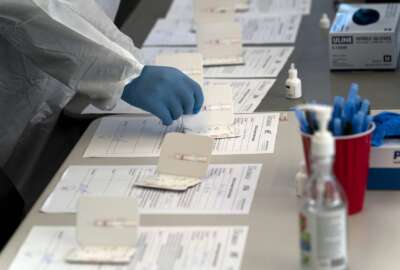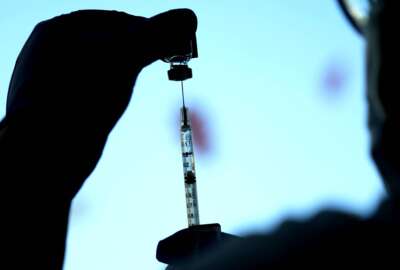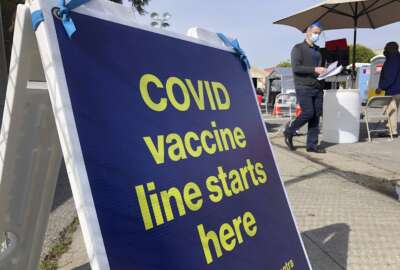Hubbard Radio Washington DC, LLC. All rights reserved. This website is not intended for users located within the European Economic Area.
DoJ expects to transition away from max telework in the coming months
The Justice Department updated its workforce safety plan from February 2021with new details about vaccination requirements and testing, about face masks and phy...
Best listening experience is on Chrome, Firefox or Safari. Subscribe to Federal Drive’s daily audio interviews on Apple Podcasts or PodcastOne.
With the cases of omicron COVID variant on the decline, more and more agencies are starting to plan for employees to return to the office.
The Social Security Administration and the Agriculture Department were among the first agencies to give employees timelines and goals for bringing them back to the office.
The Justice Department is the latest to join the small but growing bloc of agencies who plan to reopen their doors to more and more employees.
Justice updated its workforce safety plan from February 2021 with new details about vaccination requirements and testing, about face masks and physical distancing and about reporting, contact tracing and continuous monitoring.
What Justice didn’t include is any timeline for bringing employees back to the offices.
“Upon notification from the department, components will issue reentry policies with at least 30 days’ notice to employees, consistent with the Deputy Attorney General’s memorandum dated June 24, 2021. Such notices must be sufficiently flexible to account for the evolving pandemic, including changing levels of community transmission of COVID-19. Furthermore, components must comply with collective bargaining obligations, including promptly notifying their unions and providing a meaningful opportunity to consult, as required in Section 2 of Executive Order 13991,” the updated plan stated. “Components are urged to continue to build on their successful experiences during the department’s ‘maximum telework’ posture during the pandemic to provide broader access to telework and other worksite and scheduling flexibilities to employees, as balanced against mission requirements, in developing and implementing their reentry plans.”
Justice spokesman Wyn Hornbuckle, however, told Federal News Network in an email that about 67% -to-75% of the department’s workforce currently report to their official worksite, based on mission demands.
“The department is closely following Office of Management and Budget and Centers for Disease Control and Prevention (CDC) guidance related to the COVID-19 pandemic, and like other federal agencies, will transition away from maximum telework for the rest of the workforce over the next few months as pandemic conditions allow,” he said. “That transition will include advanced notice to all employees and continuing flexibilities as practicable and consistent with the department’s mission. The department’s updated workplace safety plan will address safety protocols in detail and will be provided to all employees. We will continue to closely watch rates of virus transmission around the country, and adjust our plans as necessary.”
Court ruling remains in effect
Justice joins the Social Security Administration, the Agriculture Department and a handful of other agencies that are planning on bringing employees back to the office in the coming months.
In June, OMB required agencies by the following month to develop plans to have employees return to the office. Agencies began setting tentative reentry dates until omicron threw a wrench into those plans.
An OMB official said each agency is making their own decisions based on the type of work and their mission needs as to when employees need to work on person.
“Those determinations in the coming weeks and months are shaped in part by operational considerations, as well as a commitment to the wellbeing of the federal workforce,” the official said.
The Safer Federal Workforce Task Force provided updates in late January after a district court decision in Texas issued an injunction pausing the Biden administration’s vaccine mandate. On Feb. 10, a New Orleans appeals court decided not to overturn the lower court’s decision and continue the injunction against the vaccine mandate for federal employees.
The Justice Department updated plan incorporates the courts’ decisions, particularly around unvaccinated employees.
DoJ, however, still is requiring unvaccinated employees to test regularly, and as of Feb. 9, it is asking those employees to use a third-party to verify their COVID-19 tests.
“The department is following the executive-branch-wide guidance provided by the Safer Federal Workforce Task Force. That current guidance provides that employees who are not fully vaccinated are required to be tested and may use over-the-counter (e.g. ‘at home’) tests, but such tests ‘should not be both self-administered and self-read by the employee unless observed by the agency or an authorized telehealth provider,’” Hornbuckle said. “The department’s current policy provides that unvaccinated employees who are working on-site be tested twice weekly, but components may establish weekly testing protocols based on mission needs.”
In an email Justice sent to employees, which Federal News Network obtained, DoJ said a “witness” must be any third party who has no direct connection to the employee being tested.
Testing program deadline passes
Previously, DoJ let unvaccinated employees administer their test and report their results.
Justice has one of the lowest vaccination rates across the government. Hornbuckle said about 8.1% of all employees are not vaccinated.
“With the exception of the Federal Bureau of Prisons, which has its own testing capabilities, department employees are responsible for obtaining necessary testing on their own,” he said. “Resources for locating available testing providers are available to employees who need it. Consistent with Task Force guidance, the department will reimburse employees for testing required under its policy, and required testing is done on duty time.”
In January, OMB required agencies by Feb. 15 to set up testing programs for employees and contractors who were not fully vaccinated.
Justice wrote in its updated plan that “The department encourages components to require that the negative result be obtained within the previous three (3) days (i.e., twice per week testing) before entering the worksite; however, based upon operational needs and testing availability, components may require a negative COVID-19 result once a week, particularly in areas of low or moderate transmission of COVID-19. Components should factor availability of tests into their workforce testing schedules.”
On-site contractors and visitors also must abide by the same requirements for testing.
Justice also detailed expectations around wearing masks in the office. It said unvaccinated employees, contractors and visitors must wear their masks all the time, while vaccinated employees, contractors and visitors should only wear masks in public indoor spaces like bathrooms “if the building is in a city or county designated as one of substantial or high community transmission of COVID-19.”
“When the level of community transmission of COVID-19 in the city or county of a department facility falls below the threshold for substantial, it must remain at the lower level for at least two consecutive weeks before the component may use less restrictive safety protocols. When the level of transmission increases from moderate to substantial, the component must promptly put in place more protective safety protocols,” the plan stated. “Currently, all employees are required to wear masks in common areas within a Secure Compartmented Information Facility (SCIF), regardless of vaccination status and community transmission level. For private spaces within a SCIF (e.g., personal offices with a door), masks may be removed if the occupant is alone and the door is closed.”
GOP frustrated over remote work
The perceived slow return to the office is frustrating Republican lawmakers.
The latest is Rep. Andy Biggs (R-Ariz.), who along with eight other Republicans introduced the Return to Work Act. The bill would require agencies to reinstate their telework policies used before the COVID-19 pandemic.
“Beginning on the date on which the head of an executive agency reinstates the telework policies in use by such executive agency on Dec. 31, 2019, the reinstated telework policy of such executive agency shall apply in place of any telework provision of a teleworking, collective bargaining, or other employment agreement of such executive agency to the extent that such telework provision conflicts with, or applies a different telework policy than, the reinstated telework policy of such executive agency,” the bill stated.
Rep. Dan Crenshaw (R-Texas) and Sen. Roger Marshall (R-Kan.) introduced similar bills in August that would have required agencies to return to the telework policies of Feb. 14, 2020.
Neither bill made it out of committee or even received a hearing.
Biggs’ legislation joins a growing number of similarly focused bills that want federal employees to return to the office more quickly.
Copyright © 2024 Federal News Network. All rights reserved. This website is not intended for users located within the European Economic Area.
Jason Miller
Jason Miller is executive editor of Federal News Network and directs news coverage on the people, policy and programs of the federal government.
Follow @jmillerWFED






